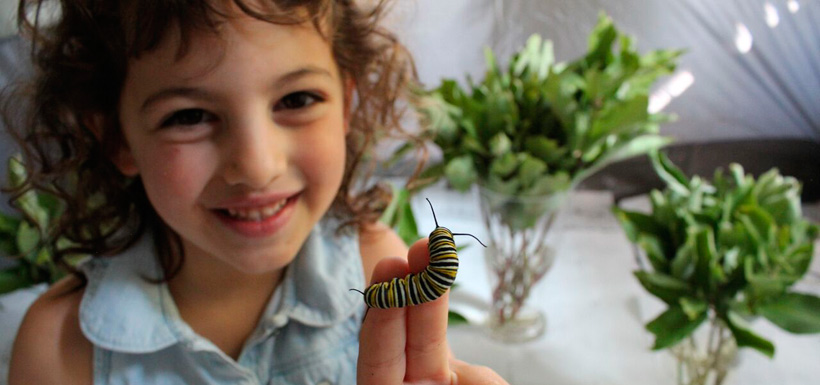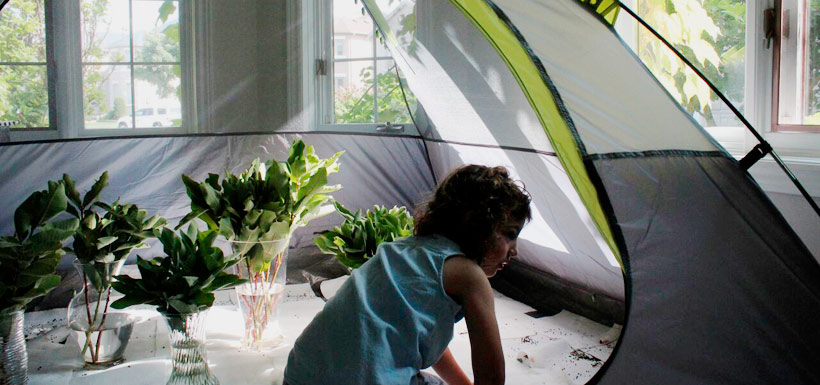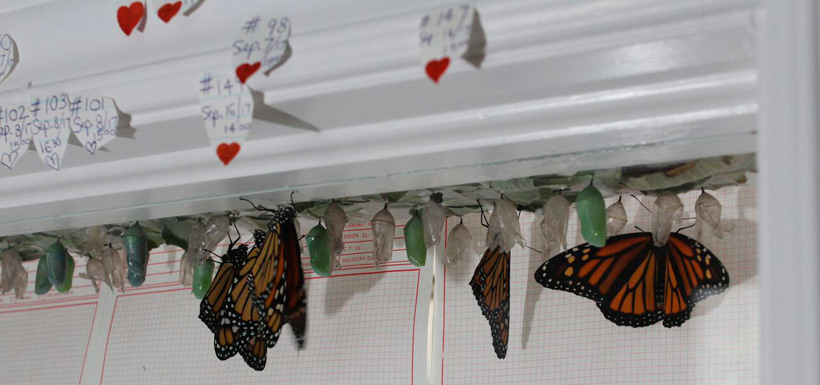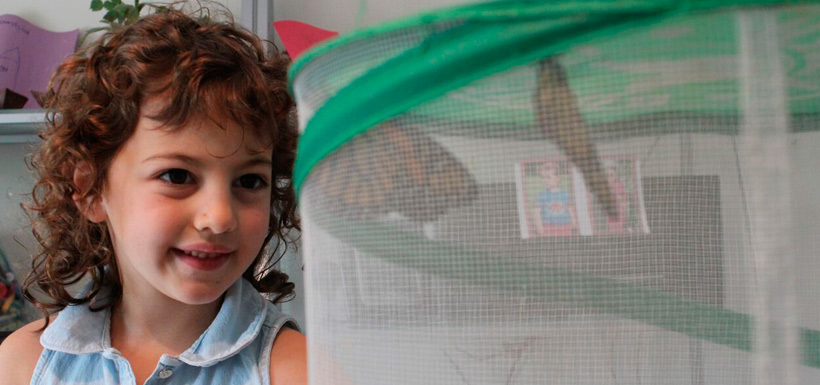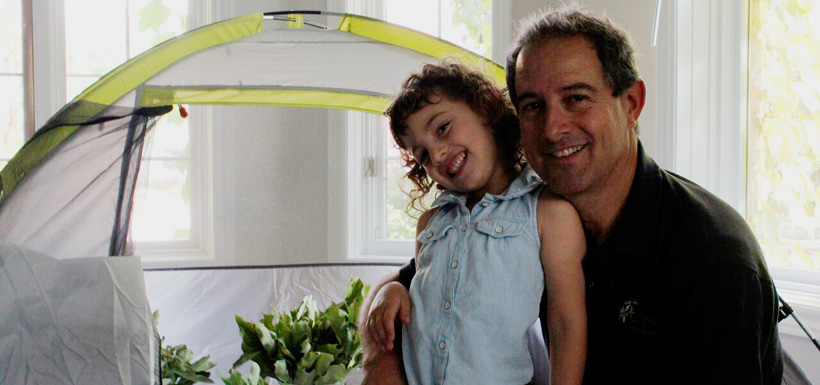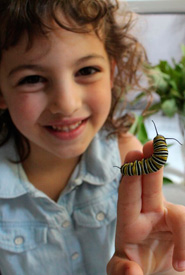A five-year-old entomologist-in-training
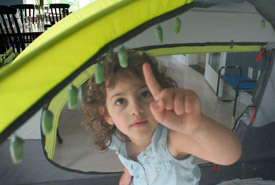
Hannah, a five-year-old amateur entomologist taking care of monarch chrysalises. (Photo by NCC)
With the help of my dad, I’d like to tell you everything I know about monarch butterflies. Don’t worry — I’ll explain the life cycle, the special habitat requirements and the incredible migration to Mexico.
By the way, I’m five years old, and I’m planning to protect monarchs for my whole life.
I’ve been searching for insects for years. Last summer, I raised a dragonfly nymph that I found in our pond’s biofilter. I asked my dad to take me all over Ontario to search for monarchs. This year, I found a few caterpillars in some pretty wild fields and brought them home to raise on milkweed.
One day, near a construction site, I was watching a female monarch flitting around in places where there were no nectar plants. Here, I found my first monarch egg on a tiny milkweed plant. I started to find white eggs, the size of sugar crystals, on the bottoms of leaves, on new flowers, on stems and even on the tops of leaves, though my dad said that was rare. I was out searching every day with my mom, my little brother and my dad. By the end of August, I’d brought home more than 300 monarch eggs and caterpillars.
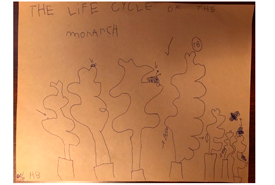
Life cycle of a monarch (Drawing by Hannah Biro)
This is my discovery: the easiest places to find lots of monarch eggs are fields that have been mowed in the middle of the summer. Females choose to lay eggs on brand new milkweed shoots. Tiny caterpillars, also called larvae, hatch after a few days and eat up their own egg case, then munch on the plant. They shed their exoskeleton four or five times as they grow.
By two weeks old, they’re large and they hang beneath a leaf in the form of a "J," then form a greenish chrysalis, also called a pupa. Metamorphosis takes place in nine to 15 days, when a shrivelled adult butterfly emerges; this is called eclosing. The adult pumps fluids into its wing veins in just a few minutes, then spends at least three hours preparing for its first flight. You can identify males by noticing two dark spots on their hind wings.
You probably guessed this already, but mating is very important. The life cycle is complete after five weeks.
Do you know how dangerous a monarch’s life can be? Wasps, praying mantis, spiders, dragonflies, birds, chipmunks and even bats attack and eat monarch larvae and adult butterflies. Parasites, such as the incredible tachinid fly, viruses, bacteria, protozoa and fungi all kill this species of special concern. Pesticides, mowing, ploughing, drought, floods, fire, freezing, wind, cars and waves can all be deadly to monarchs. If that’s not enough trouble, eggs and tiny caterpillars can even be eaten by bigger caterpillars. Some females can’t even find milkweed plants to lay eggs on. Some monarchs can’t find nectar plants to sip from, and these ones might not make it to Mexico. Migrating takes energy, perfect wings, a good sense of direction, fabulous weather conditions and one more thing: luck!
The story continues under the slideshow below.
An early spring sighting of a monarch butterfly in Ontario was made by my dad at the tip of Point Pelee, in Ontario, this past May first. There can be five or six generations of monarchs each summer, but the last one, I love to call the Super Generation, doesn’t breed in Canada. Instead, it migrates in the millions to the Mariposa Monarca Biosphere Reserve in central Mexico. Instead of living for five weeks, it survives for seven or eight months, overwintering in fir, pine and oak forests in extremely high mountains, then flying north to mate and reproducing in the United States. A brand-new generation completes the migration to Canada. Super incredible!
One day, on the news, I saw that Hurricane Harvey was hitting Houston. That same day, I found 48 monarch eggs and caterpillars. I worried about my monarchs migrating through Texas. For three months, we released butterflies, in the hundreds, in our backyard, almost every day. On the day of my school’s Terry Fox run, my little brother and I thought of Terry Fox as we released eight monarchs back into the wild. On the day I saw the Mexican earthquake on TV, I hoped the butterflies in the Reserva Monarca would be safe. That was September 19, the only day we didn’t release a single monarch.
When I brought four monarchs on a field trip into my school’s ravine, I realized that my butterflies make my classmates feel like they’re part of nature.
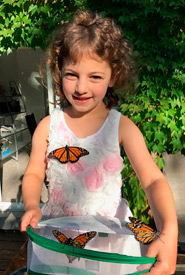
Hannah releasing monarchs in her backyard (Photo by Michael Biro)
When I was young, I used to say I wanted to be an entomologist. Now, I’m really sure I’ll become a biologist because I’m obsessed with tardigrades, viruses, bacteria, amoebas, leeches, spiders and snakes! When I grow up, I’m planning to have a research laboratory in the Canadian wilderness, where I’ll keep my microscopes, think of ways that people can save wild creatures, such as goblin sharks, and discover new species of insects. I’ll be a teacher, too.
Do you know that monarchs have gone through metamorphosis on the International Space Station? It’s a true wonder of nature. On my birthday, but, actually, two years before I was born, the Space Shuttle Atlantis crew brought monarch eggs and caterpillars to the Station. Our amazing Canadian astronaut, Robert Thirsk, was already in space, so he raised adult butterflies in special facilities, almost like the setup I’ve got in our living room.
This winter, I’d love to visit my butterflies in Mexico. These are just some of my thoughts and I’ll tell you more the next chance I get.
I can’t believe the monarch is such an amazing butterfly. I love that it’s pretty, and that it’s part of biology. There’s something new to learn about it every single day. That’s what science is about. If more people care about monarchs and their habitat, we can all save this insect from becoming extinct. That’s what imagination can do.
Check out a video of Hannah raising and releasing monarchs in her backyard, below.

